Radiant Bond by Alvaro Herrero (Mekan) (Spain).
Every year, during the southern winter, I travel to French Polynesia to photograph these majestic animals.
The spearing light is dramatic, while the shadow the calf is casting on its mother is subtle.
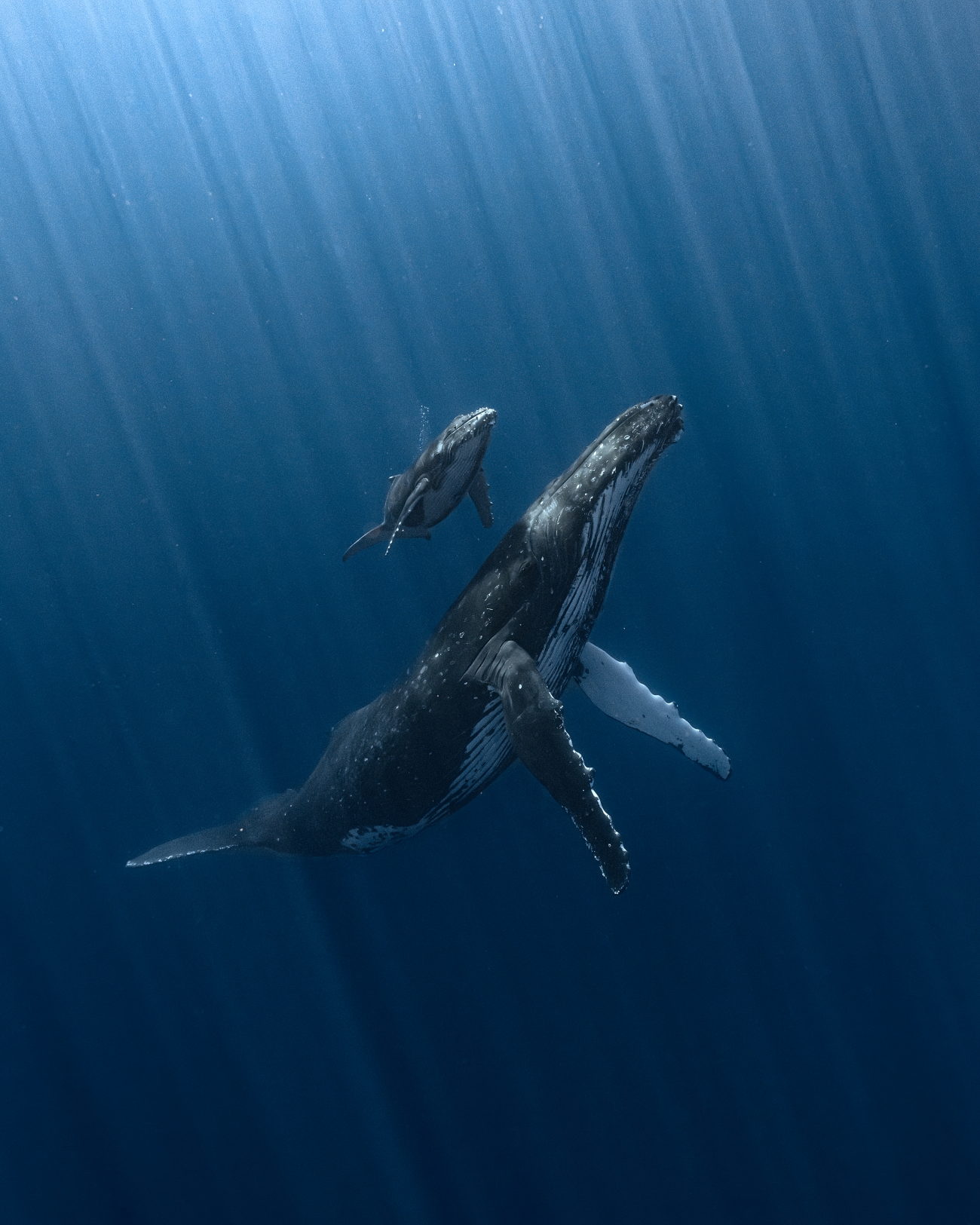
“Radiant Bond” by Alvaro Herrero (Mekan) (Spain). Winner, Underwater Photographer of the Year and Winner, Wide AngleLocation: Mo’orea, French Polynesia“A mother humpback whale accompanies her calf to the surface for its first breath early in the morning. The youngster is releasing a few bubbles as it rises, perhaps this is because it is still learning to control its breathing, or it is simply experimenting with its own body. Every year, during the southern winter, I travel to French Polynesia to photograph these majestic animals. My favorite time of day is the early morning, because the light is soft and angled, allowing me to find the perfect angle to clearly define the shape of these animals in blue. For me, this photo is one that shows a mother’s love for her calf, communicating both the fragility and beauty of our oceans, and revealing one of the amazing species with whom we share our home world.”
Herrero triumphed over 6,750 underwater pictures entered by underwater photographers from around the world.
Other stand-out images includeRurukas creative photo of a cenote sinkhole in Mexico.
The photograph landed him the title of 2025 Marine Conservation Photographer of the Year.
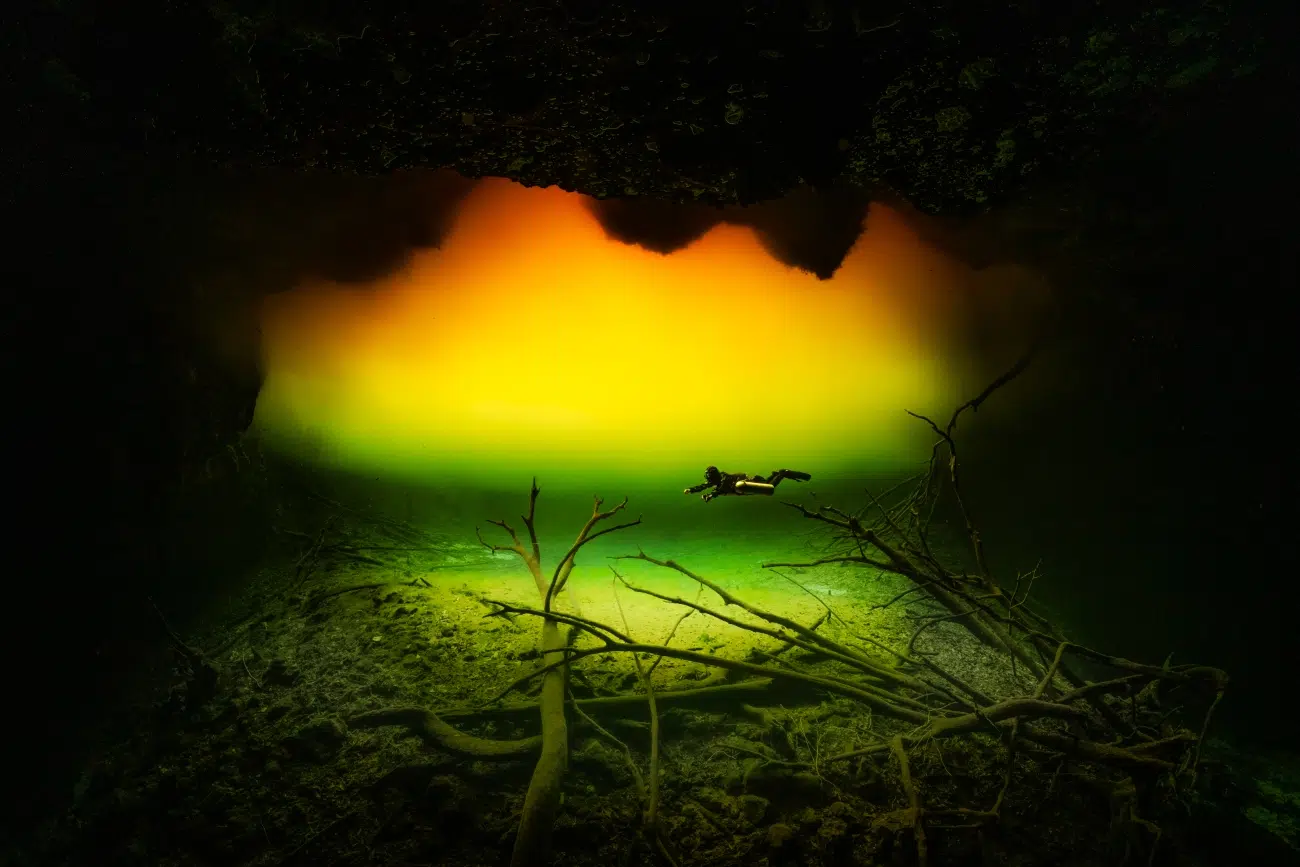
“Aurora Underwater” by Ruruka (Korea). Winner, Up & Coming Underwater Photographer of the YearLocation: Cancun, Mexico“I first traveled to Cancun, Mexico, for a shoot two years ago, and since then, I’ve been captivated by its charm. These days, I find myself visiting Cancun frequently. From where I live, it’s a very long journey – about 24 hours by plane – but this place perfectly aligns with the direction of my photography and offers a variety of shooting opportunities. To capture this particular photo, I visited during the rainy summer season and worked with a local Korean guide as my model. “
The composition is immersive, and the timing, capturing the fishermans gesture, is decisive, says Mustard.
A picture that takes you straight into the story.
Here are the incredible winners of the 2025 Underwater Photographer of the Year competition.
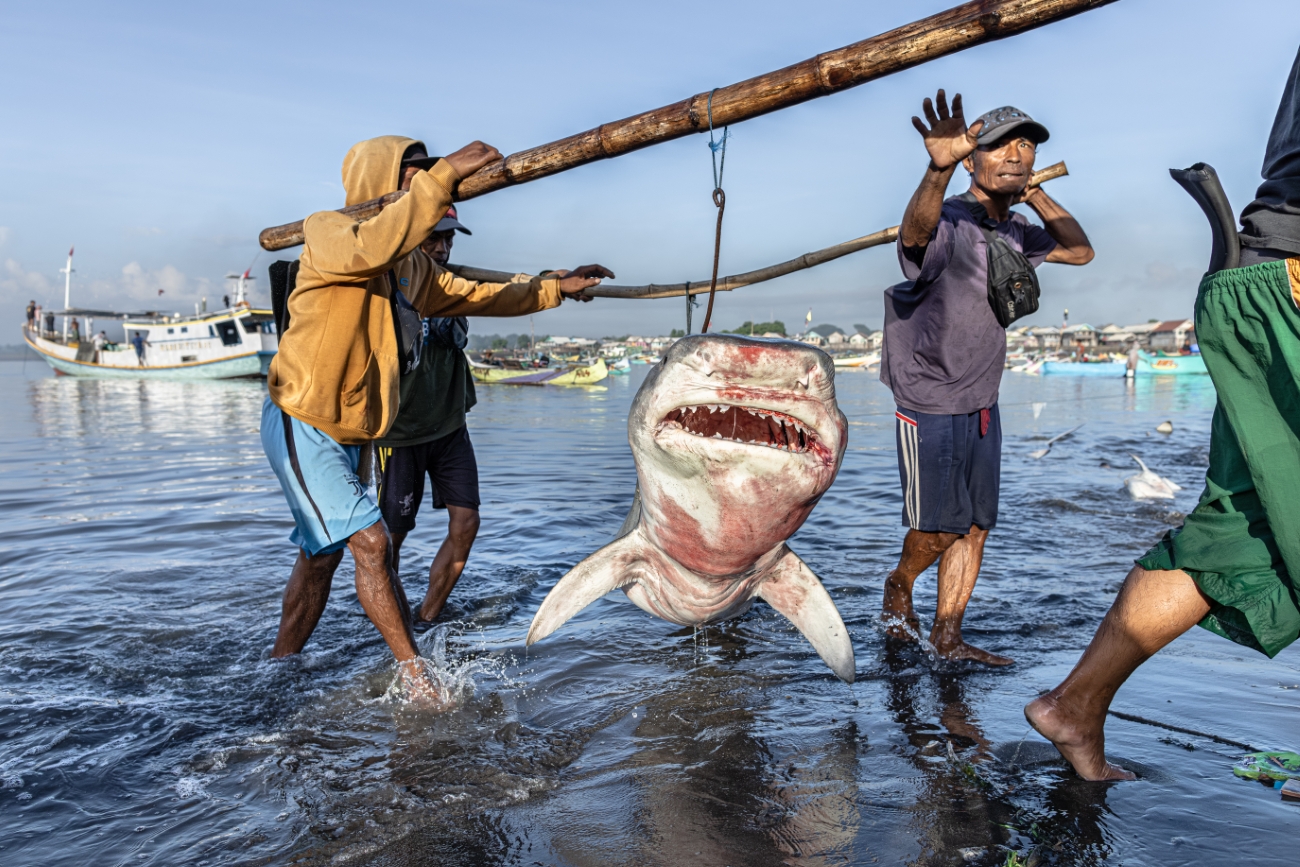
Robert Marc Lehmann (Germany). Winner, ‘Save our Seas' Marine Conservation Photographer of the YearLocation: Indonesia“This tiger shark is just one of around 200 million sharks that lose their lives every year at the hands of humans.Since I was six years old (35 years+), I have been intensively studying sharks. In all these years, hardly anything has changed and that is frustrating. Sharks protect their habitat, the sea, through their ecological function as “health police”. Over a billion people depend on the sea every day and we all breathe the oxygen that is largely produced in the sea. If we continue to eradicate the animals that guard our largest and most important habitat, we are taking away our own livelihood. And that’s why I’ve been fighting for people to see and understand sharks through my eyes. Every time I take a photo like this, it hurts, but through imagery I can inspire millions of people to understand sharks and their situation and make a difference.”
Aurora Underwater by Ruruka (Korea).
These days, I find myself visiting Cancun frequently.
Robert Marc Lehmann (Germany).
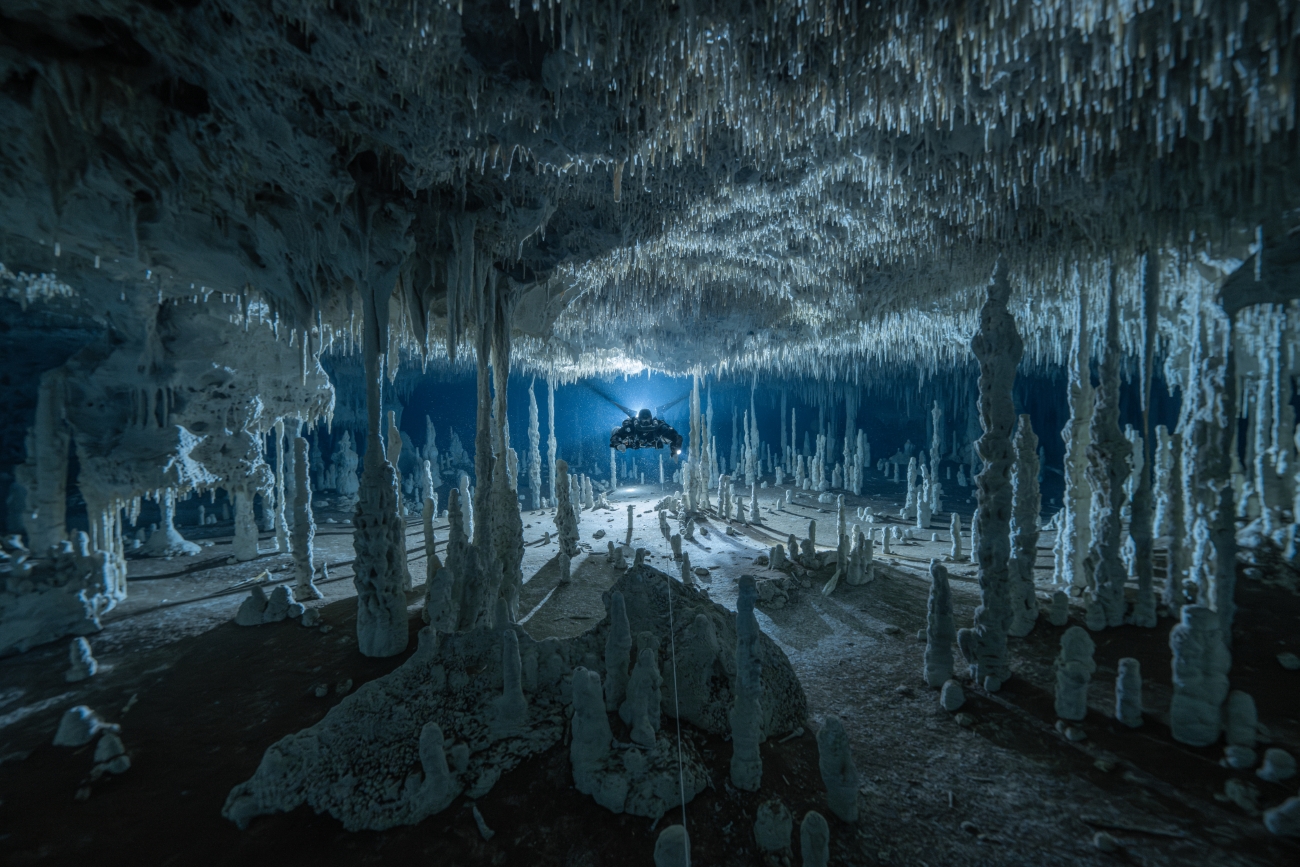
“Ethereal Moonscape” by Alvaro Herrero (Spain). Runner-up, Wide AngleLocation: Tulum, Mexico“A diver using a rebreather glides through one of my favorite caves in the Yucatán Peninsula. The rebreather was a critical piece of equipment for this shot. Using rebreathers in the caves allows us to spend much more time exploring their depths, and enhances my photos as it gives us the opportunity to precisely illuminate the scene. By not emitting bubbles, we also help protect the features of the cave features and disturb far fewer particles, which is particularly advantageous when photographing less-frequented spots. Rebreathers also deliver much more efficient decompression times. To illuminate this room, we used 60,000 lumens of warm light from two BigBlue video lights.”
In all these years, hardly anything has changed and that is frustrating.
Sharks protect their habitat, the sea, through their ecological function as health police.
And that’s why I’ve been fighting for people to see and understand sharks through my eyes.
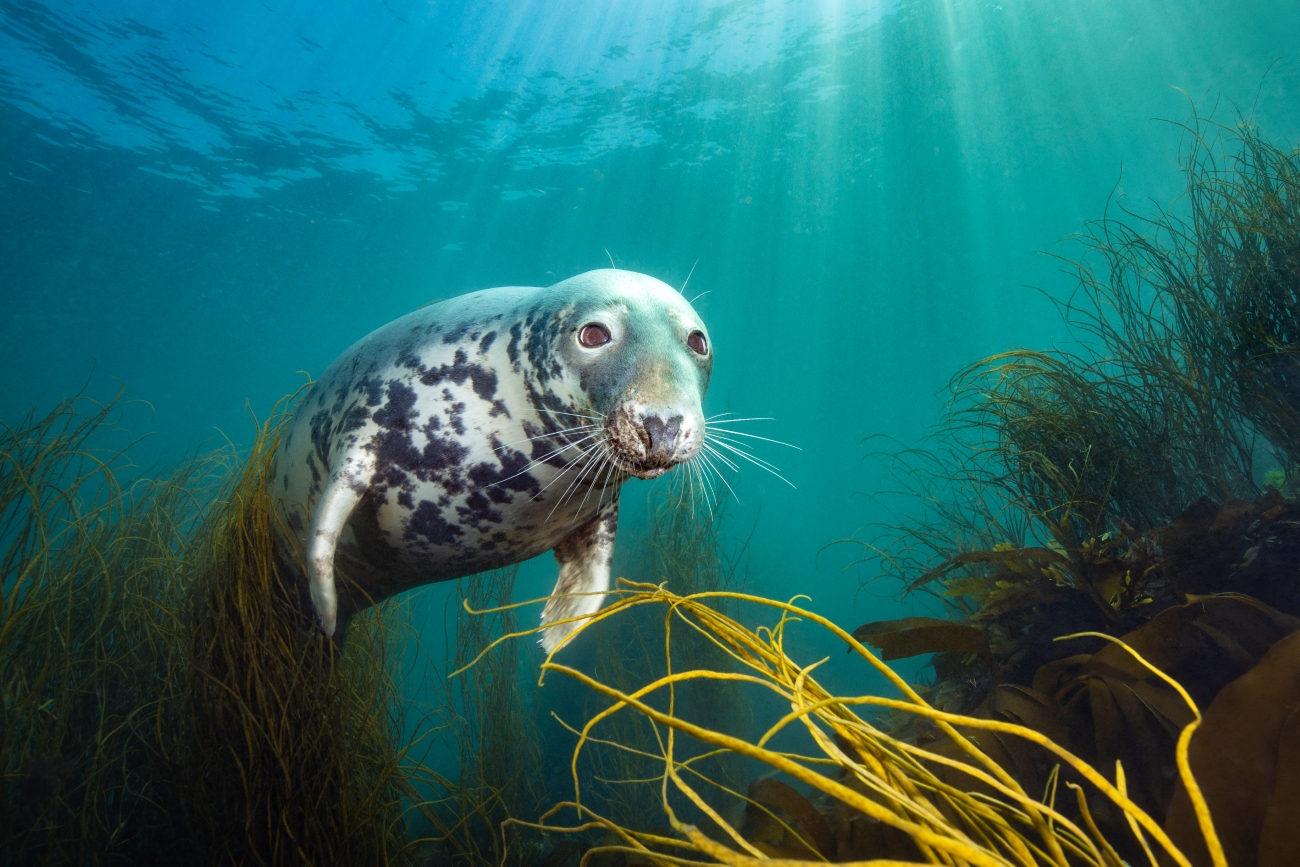
“The Curious Seal” by David Alpert (UK). Winner, British Underwater Photographer of the Year and Winner, British Waters Wide AngleLocation: Lundy Island, UK“North Devon is easily one of the most beautiful coastlines in Britain. High jagged cliffs pounded by an unforgiving sea. With the second-highest tide change in the world, the outgoing current whips up against waves and wind rolling in from the North Atlantic. Stand back and marvel.Diving windows are limited, so I based myself in the area for two months last year, exploring different locations. This shot shows a grey seal off Lundy Island, a marine protected area since 1973. Seals are delightfully curious creatures, more interactive than any other species I have dived with around the world. Briefly, I become one of the privileged few, crossing the bridge into the world of a sentient wild animal.”
Ethereal Moonscape by Alvaro Herrero (Spain).
The rebreather was a critical piece of equipment for this shot.
Rebreathers also deliver much more efficient decompression times.

“Fluo Spiny Squat Lobster” by James Lynott (UK). Winner, Most Promising British Underwater Photographer and Runner-up, British Waters MacroLocation: Inveraray, Loch Fyne, Scotland“This image was taken on a wonderful night dive at Inveraray, Loch Fyne. This site is known for being home to many beautiful fireworks anemones at shallow depths, but it also has an old pipe covered in concrete blocks which is home to lots of life, including the spiny squat lobster. These squat lobsters are usually found clinging upside down on boulders/overhangs and disappear the instant the camera shutter is pressed. However, on this night dive they were wondering about in the open and didn’t seem to mind having a few pictures taken. These squat lobsters show the brightest fluorescence I have seen in crustaceans and I was really pleased on this dive to be able to capture the whole animal in frame. I used excitation filters on my strobes, along with a yellow barrier filter in front of the lens to capture the fluorescence.”
To illuminate this room, we used 60,000 lumens of warm light from two BigBlue video lights.
The Curious Seal by David Alpert (UK).
High jagged cliffs pounded by an unforgiving sea.
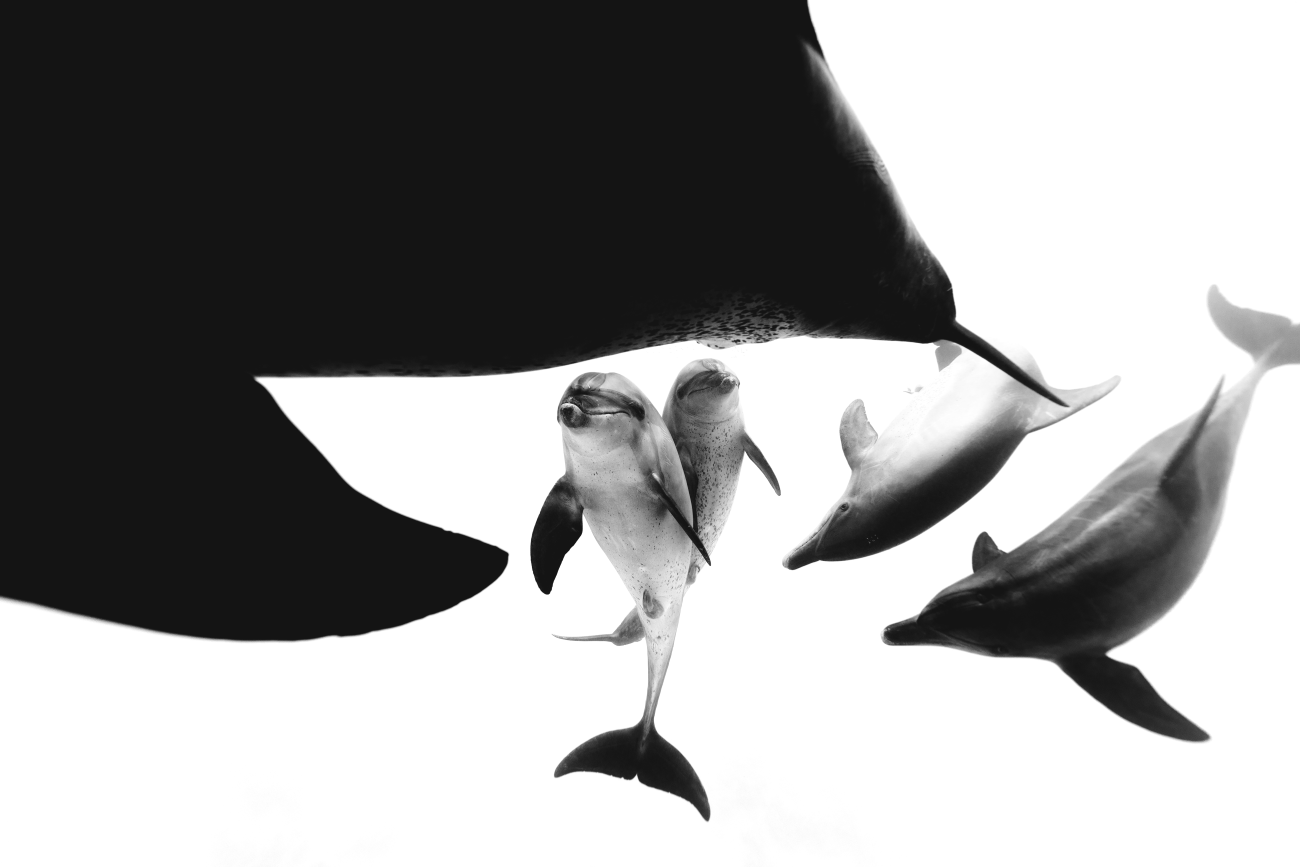
“Chasing Dolphins” by Enric Gener (Spain). Winner, Black & WhiteLocation: Red Sea, Egypt“This image was captured in the northern Red Sea during a freediving expedition in search of bottlenose dolphins. The moment portrays an intimate mating ritual, where several males—four visible in the picture, though others were nearby—were playfully chasing a female. It was a dynamic and ritualistic display, with the males engaging in friendly skirmishes and occasionally mating with the female, their bodies joining briefly for just a few seconds. Notably, the female was not attempting to escape; she actively participated, playing along and waiting for them. The entire group swam gracefully and at a slow, deliberate pace, creating a mesmerizing underwater scene.”
This shot shows a grey seal off Lundy Island, a marine protected area since 1973.
Seals are delightfully curious creatures, more interactive than any other species I have dived with around the world.
Fluo Spiny Squat Lobster by James Lynott (UK).
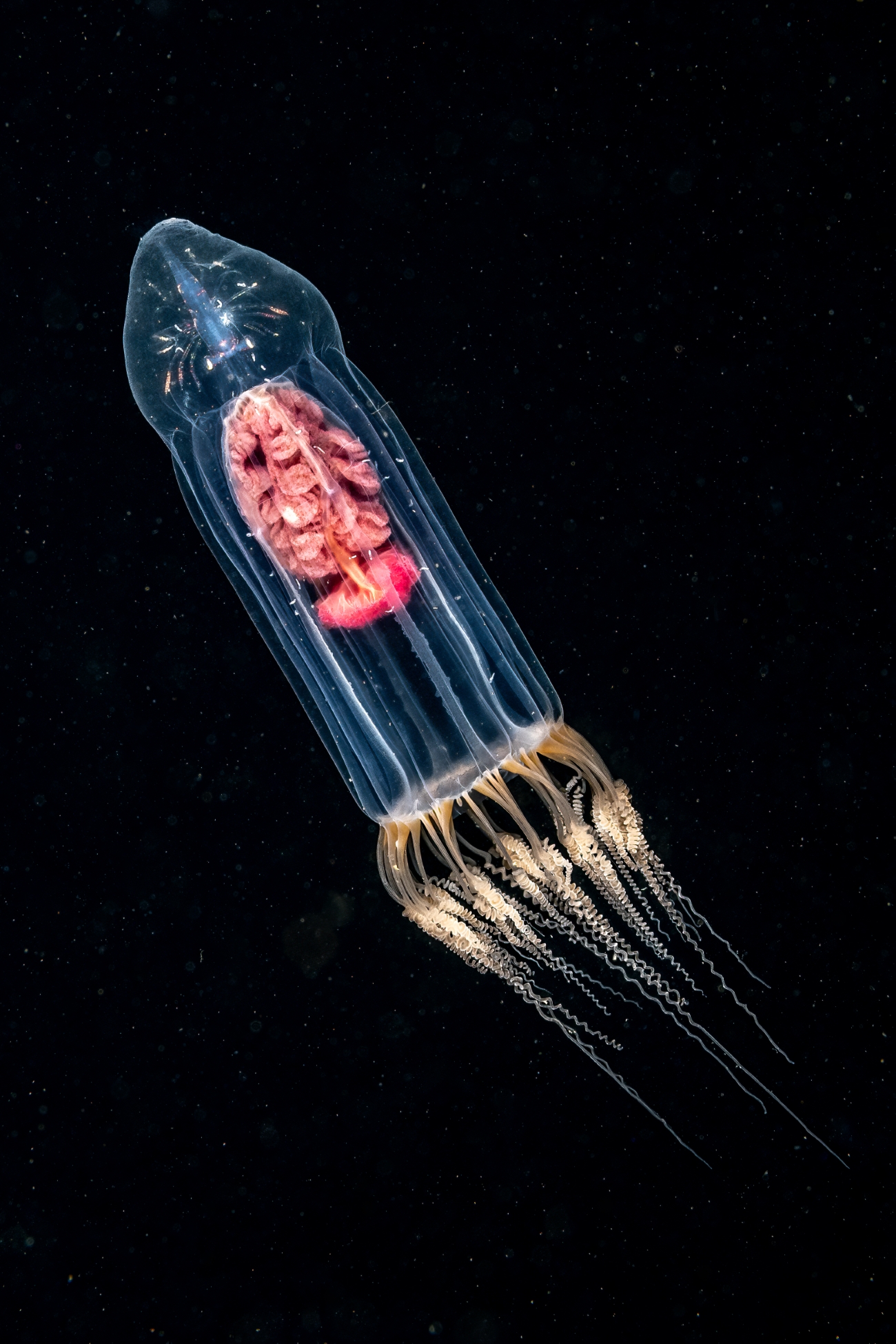
“The Hitch Hiker” by Dan Bolt (UK). Winner, British Waters MacroLocation: Scotland“Occasionally in my time under the water I have come across this medusa ‘Neoturris pileata’ in the open water but had not taken a decent photo of one. On this occasion however, my buddy and I were specifically targeting them and other similar creatures to try to explore the idea of UK ‘blackwater’ photographic opportunities. Of the many, many(!), images I took that day, this one revealed a larval crustacean within the bell of this medusa. The frames either side of this capture actually show that the larval crab (or lobster) is actually on the outside of the bell, but in this instant it was perfectly on the opposite side from me and hence the effect of being contained within the transparent body.”
Over 6,750 underwater pictures were entered by underwater photographers from around the world.
Chasing Dolphins by Enric Gener (Spain).
The entire group swam gracefully and at a slow, deliberate pace, creating a mesmerizing underwater scene.
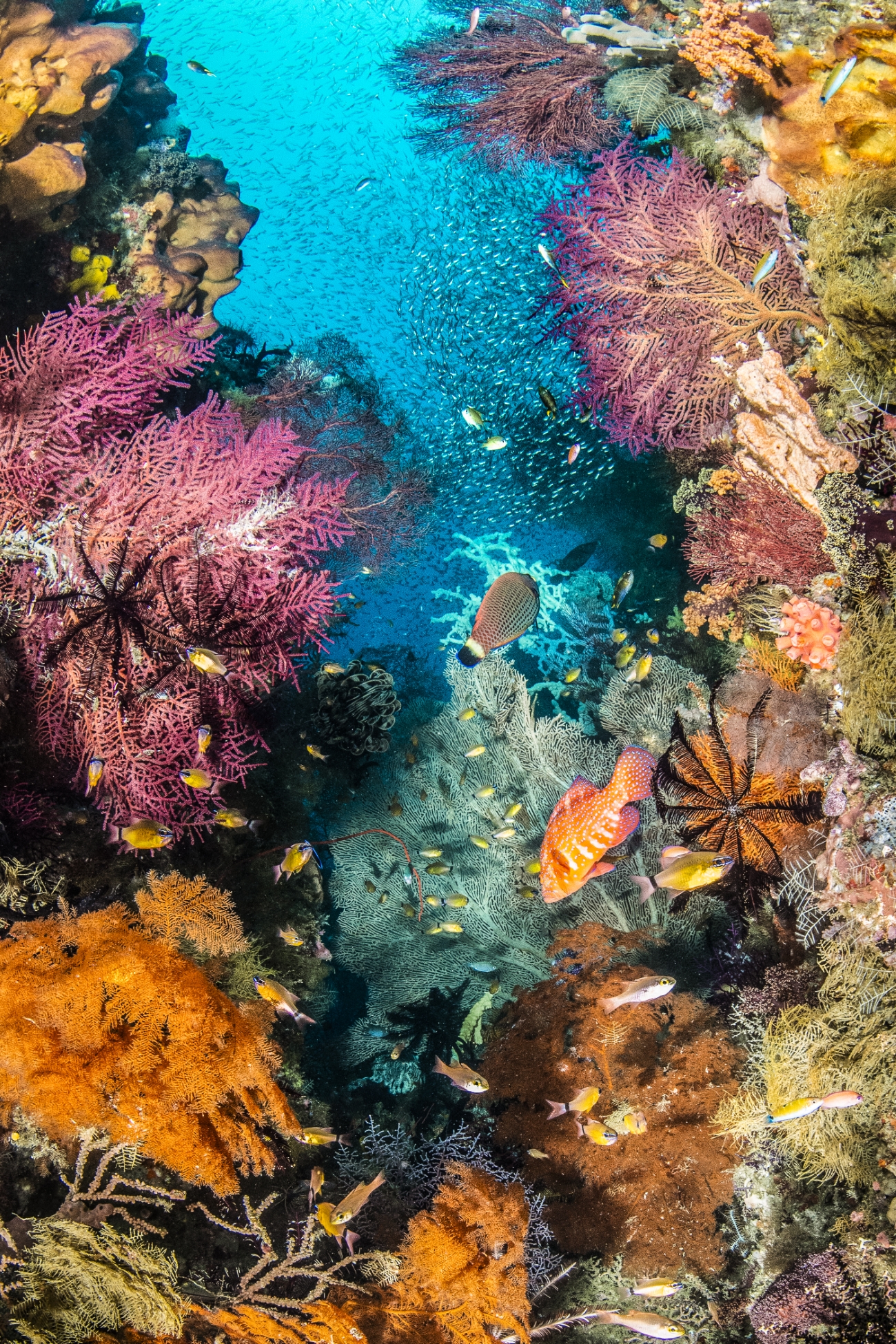
“Kaleidoscope of Colour” by Catherine Holmes (UK). Winner, Coral ReefLocation: Gorgonian Passage, Wayil Batan Island, Misool, Raja Ampat, Indonesia“Raja Ampat, Indonesia, is a magical destination where the color, beauty, biodiversity and dense fish life can almost be an overload on the senses- a celebration of healthy reef life. I was lucky to find perfect conditions with clear water and schooling baitfish swirling amongst the canyons of a large coral bommie, adorned with verdant soft corals. I aimed to capture the reef teeming with life and color to inspire us all to protect this valuable habitat. All around the world, our oceans, and in particular the coral reefs, are under threat. They are vital habitats for the myriad of species they support, and critical for the ocean’s health. Climate change, pollution, overfishing and destructive fishing all threaten this environment, and the devastating outcomes are seen worldwide with bleached and dying reefs, with dwindling fish life. Awareness is essential to protect and sustain these precious environments for the future.”
The Hitch Hiker by Dan Bolt (UK).
Of the many, many(!
Kaleidoscope of Colour by Catherine Holmes (UK).
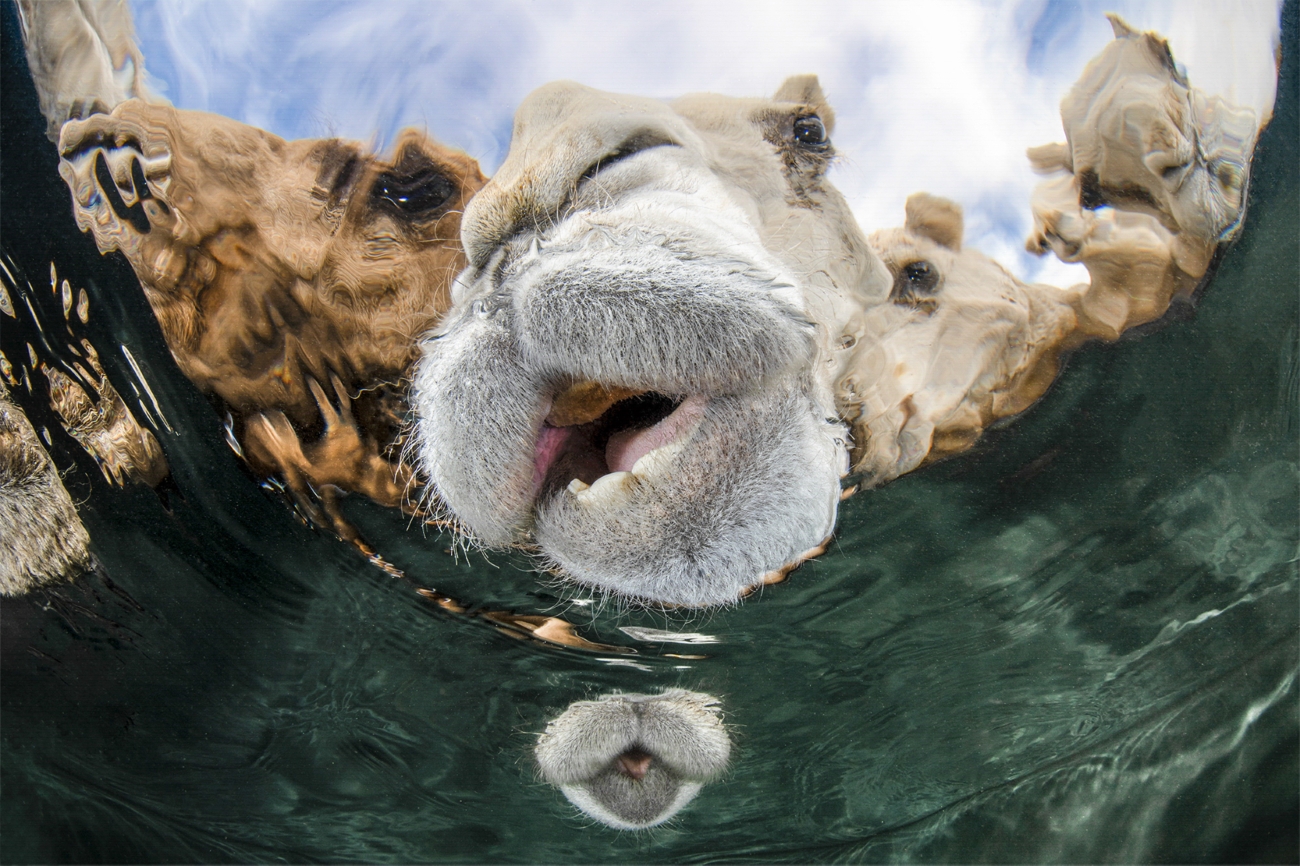
“Hydration” by Abdulaziz Al Saleh (Kuwait). Winner, PortraitsLocation: Al Wafra desert, Kuwait“I had the idea of photographing the camels drinking water for about one and half a years. I wanted to photograph them drinking water from the underwater perspective because I did not see any images showing this. The weather was a critical, and it took me several weeks to get the best possible shots. The first week the camels were a bit hesitant to drink water while my camera was under the water and only few gathered to drink, which is not what i wanted. But after several days the camels had already accepted to me and my equipment.After my first week of shooting the Camels, I changed to electronic synch cords for my strobes instead of fiber-optic cables because of problems. And finally, the shots came together.”
All around the world, our oceans, and in particular the coral reefs, are under threat.
They are vital habitats for the myriad of species they support, and critical for the ocean’s health.
Awareness is essential to protect and sustain these precious environments for the future.
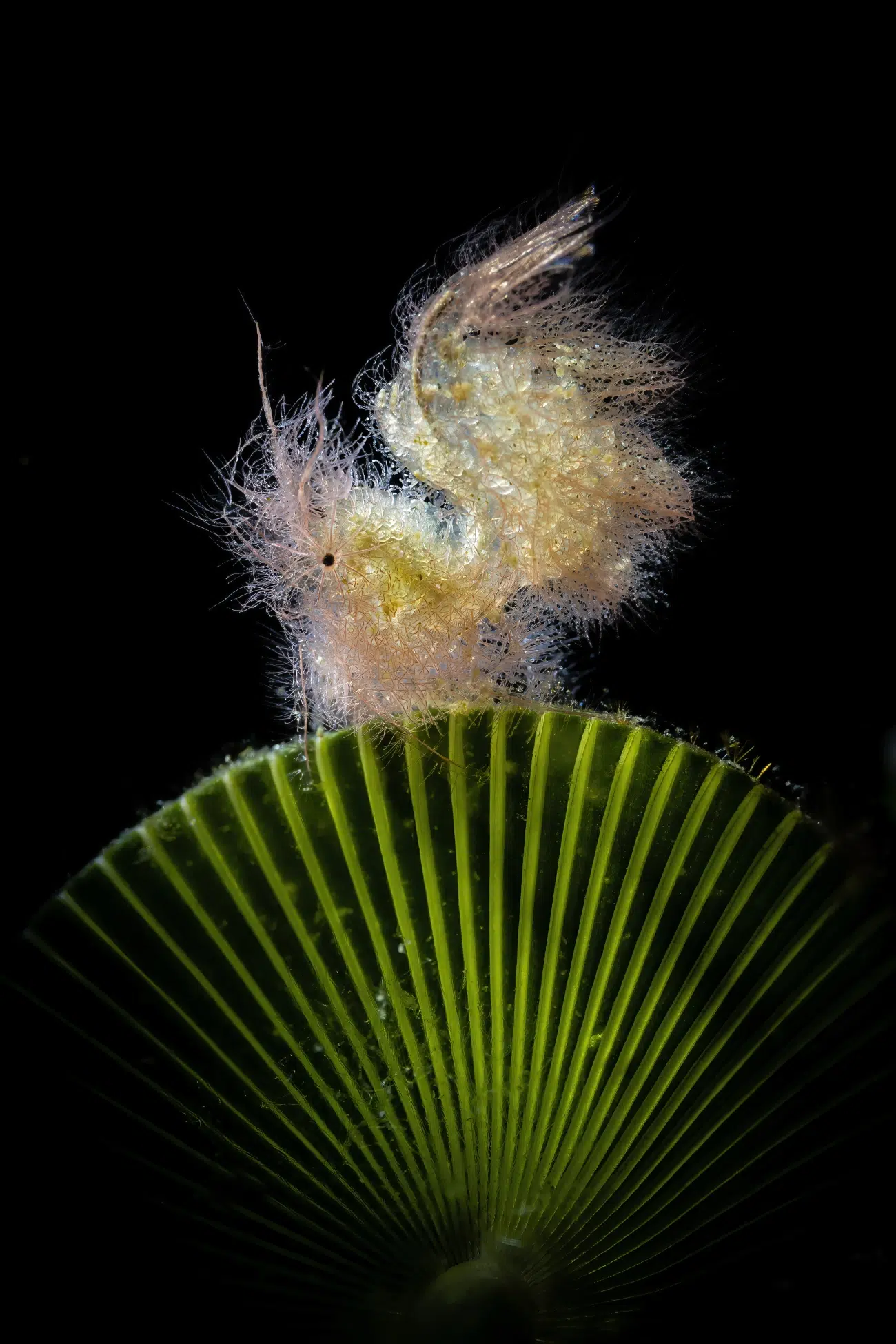
“Magic backlit” by Paolo Bondaschi (Italy). Winner, MacroLocation: Secret Bay, Anilao, Philippines“At the end of this dive, I spotted a couple of underwater photographers focused on shooting, and it piqued my curiosity about what they were photographing. I signaled to my guide to check what they were shooting. After realizing that it was one of my favorite subjects, a hairy shrimp, I waited patiently for my turn and used the time to plan and prepare for the shot. I chose to shoot it in profile, backlight with a snoot. My guide and my buddy played a fundamental role in expertly managing the light of the snoot. After a few test shots to find the right setting, I finally got the photo I was looking for.”
Hydration by Abdulaziz Al Saleh (Kuwait).
The weather was a critical, and it took me several weeks to get the best possible shots.
And finally, the shots came together.
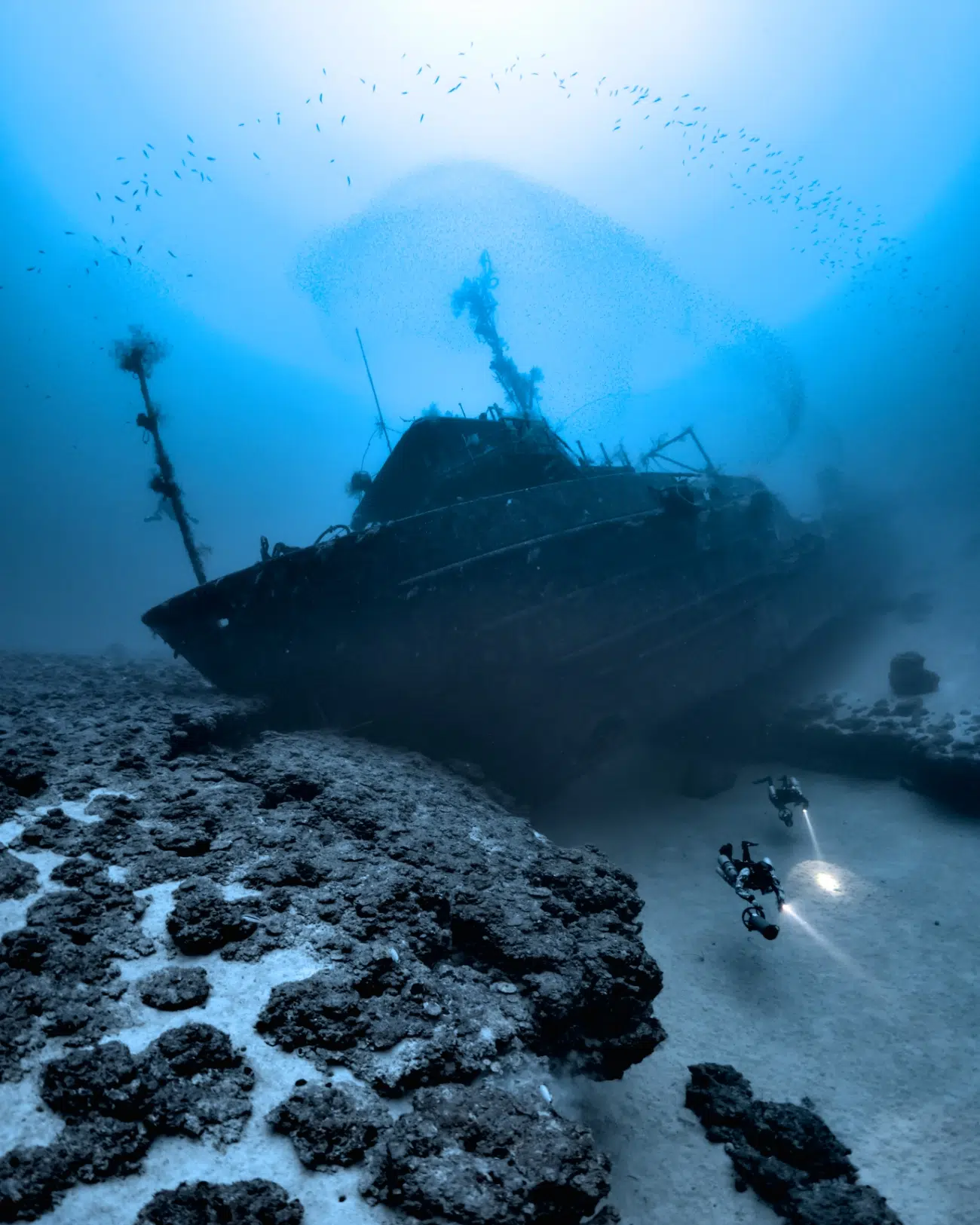
“Deep wreck” by Alex Dawson (Sweden). Winner, WrecksLocation: Gulf Fleet No 31 wreck at Shaabruhr Umm Qammar, Egypt“The wreck sits on the reef at around 104m depth. When she sank she got wedged between the reef wall and a small reef so there is a swim through under the wreck. We did 25 min bottom time and about 2 1/2 hours of deco to produce this image.”
Magic backlit by Paolo Bondaschi (Italy).
I signaled to my guide to check what they were shooting.
I chose to shoot it in profile, backlight with a snoot.
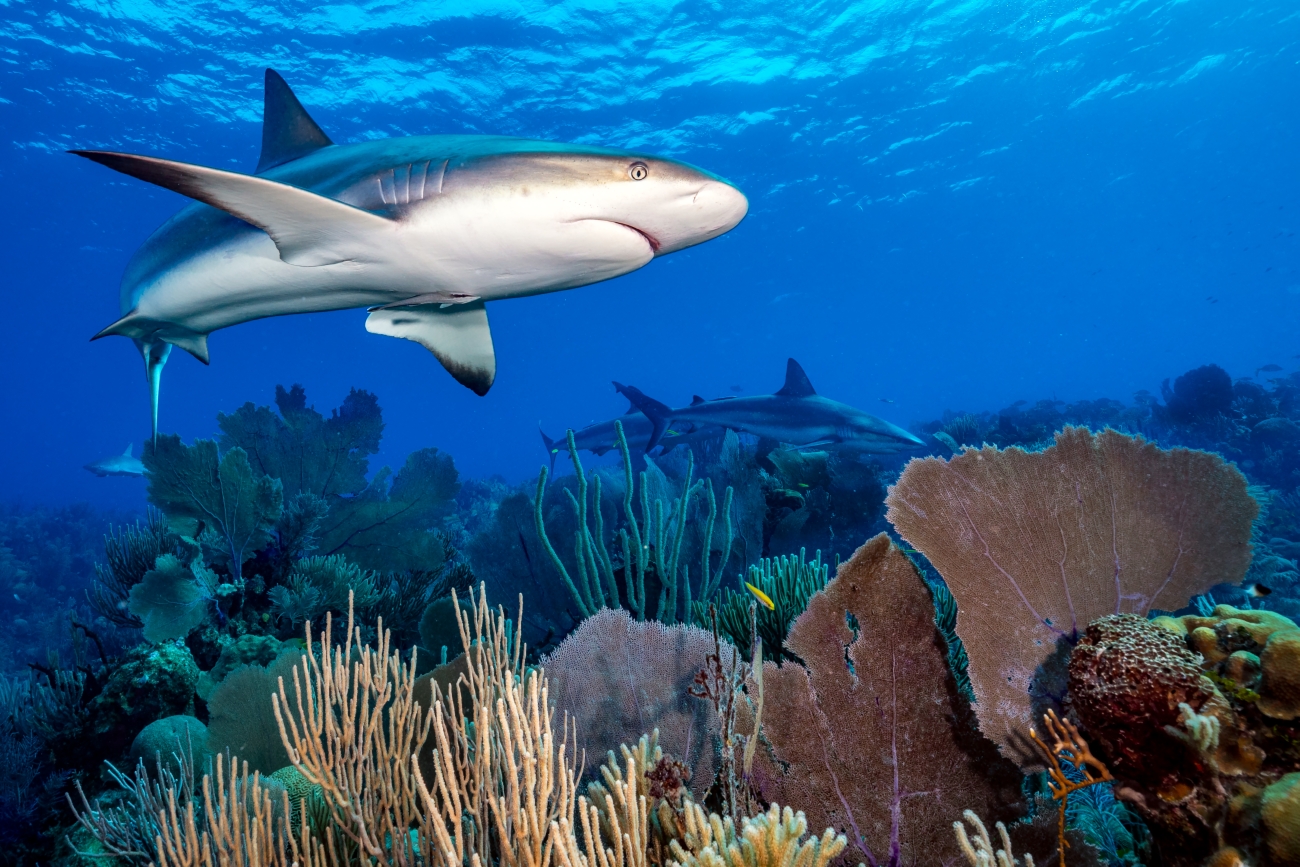
“Gardens of the Caribbean Reef Shark” by Jenny Stock (UK). Runner-up, Coral ReefLocation: Jardines de la Reina, Cuba“Filling my frame with purple sea fans and porous sea rod, I settled low on the seabed, concealing myself and my camera as much as possible in the hope of a close pass from the circling Caribbean reef shark. Hunkered down, I waited for the perfect moment. Finally, this creature elegantly swam into my frame, its shiver visible in the background, adding dramatic depth to my image. Jardines de la Reina has been a successfully protected national marine park since 1996. Today, fishing and visitor numbers are restricted, and its ninety-mile-long archipelago of reefs are renowned for pristine corals and flourishing marine life. Caribbean reef sharks can grow up to three meters long and are one of the largest apex predators in the reef ecosystem.”
My guide and my buddy played a fundamental role in expertly managing the light of the snoot.
Deep wreck by Alex Dawson (Sweden).
We did 25 min bottom time and about 2 1/2 hours of deco to produce this image.
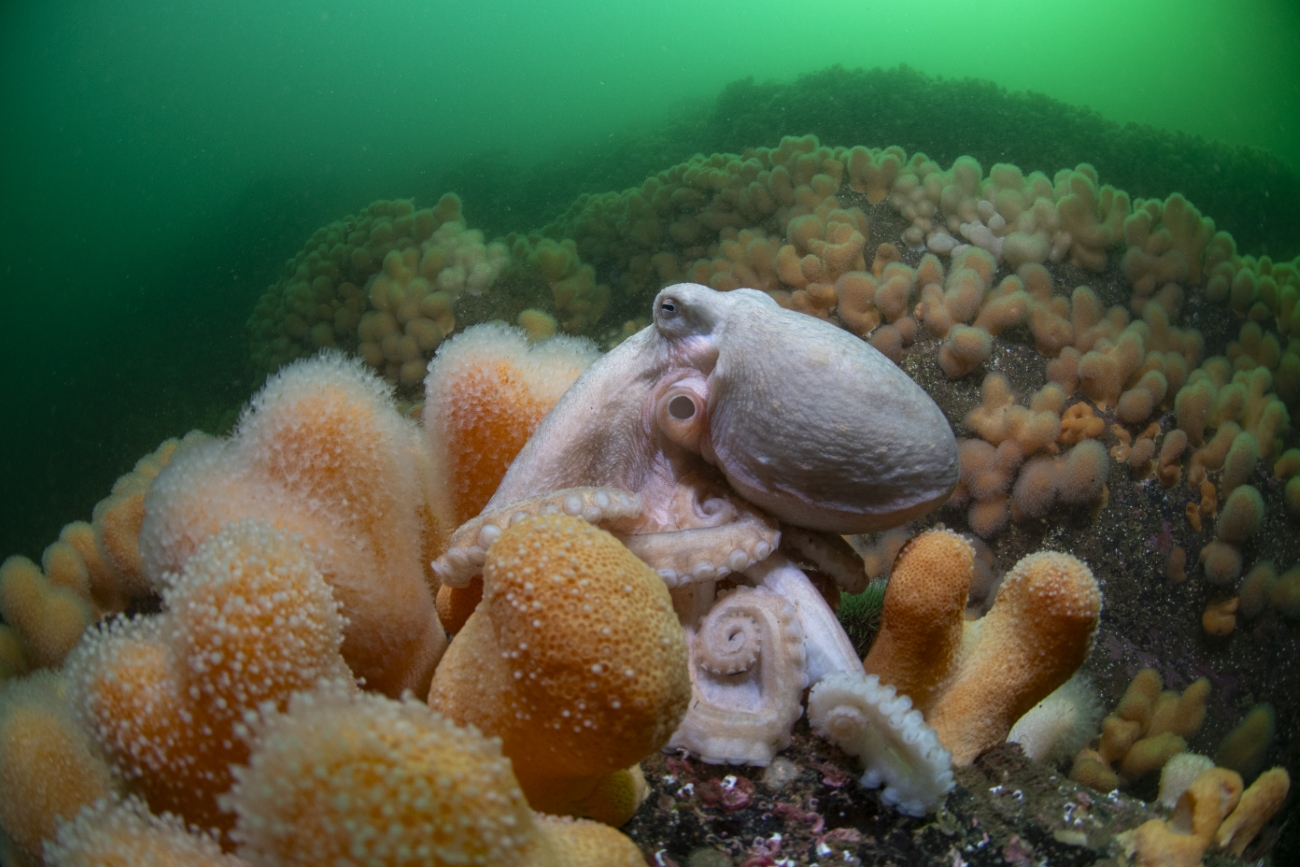
“Curled octopus (Eledone cirrhosa) with soft coral” by Simon Temple (UK). Runner-up, British Waters Wide AngleLocation: Loch Carron, Scotland“My encounters with octopuses in the UK are usually unplanned. This one was no exception. It was early May, and visibility was poor. I chose my widest lens and planned to drift along the reef with the flood tide, capturing what I could among the soft corals.Midway through the dive, the current surged unexpectedly, turning our gentle drift into a rapid ride. Then I saw it: an octopus perched high on the reef wall. I kicked hard against the current, raising my camera as it observed me calmly. The tide was relentless, and I managed only four shots before it pulled me away. As I drifted, I glanced back for one last look. The octopus remained, seemingly unfazed by our encounter, but out of range.”
Gardens of the Caribbean Reef Shark by Jenny Stock (UK).
Hunkered down, I waited for the perfect moment.
Jardines de la Reina has been a successfully protected national marine park since 1996.
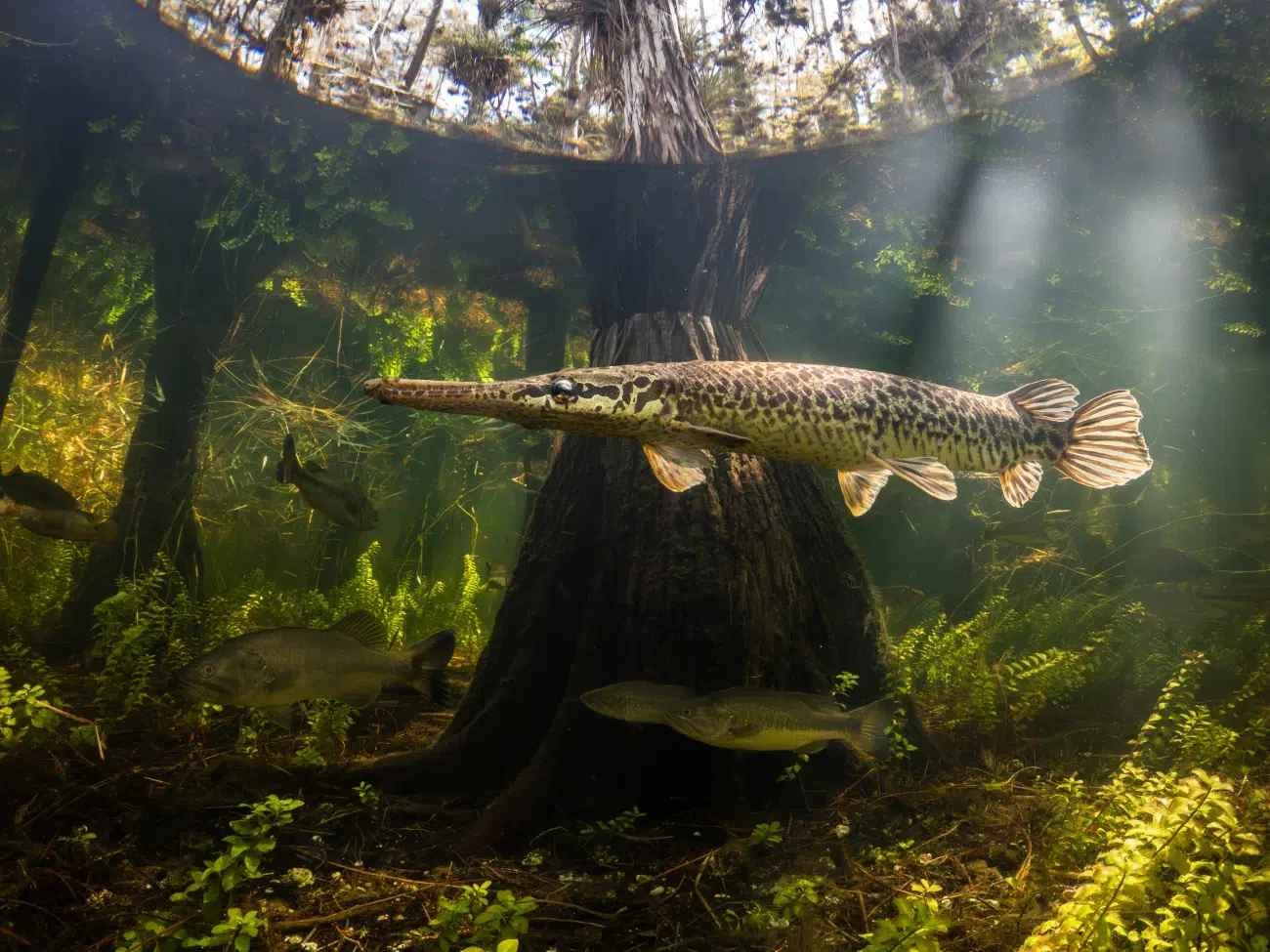
“The Beauty of the Swamp” by Bryant Turffs (USA). Winner, CompactLocation: Everglades National Park, United States“I captured this image at one of my favorite locations within the Everglades ecosystem. Historically, I primarily dove in saltwater, but I have become enamored by this foreboding environment, with clear waters, light filtering through cypress trees, and the fish species, both native and introduced. I have revisited this spot many times trying to capture various subjects and the light just right. The water levels vary significantly, sometimes completely drying, during different times of year. The fish species are in constant flux, and this location is often dominated by exotics. Ironically, on this occasion, I hadn’t invested too much thought and I was enjoying the scenery when this Florida Gar positioned itself perfectly in the frame of my GoPro.”
Curled octopus (Eledone cirrhosa) with soft coral by Simon Temple (UK).
This one was no exception.
It was early May, and visibility was poor.
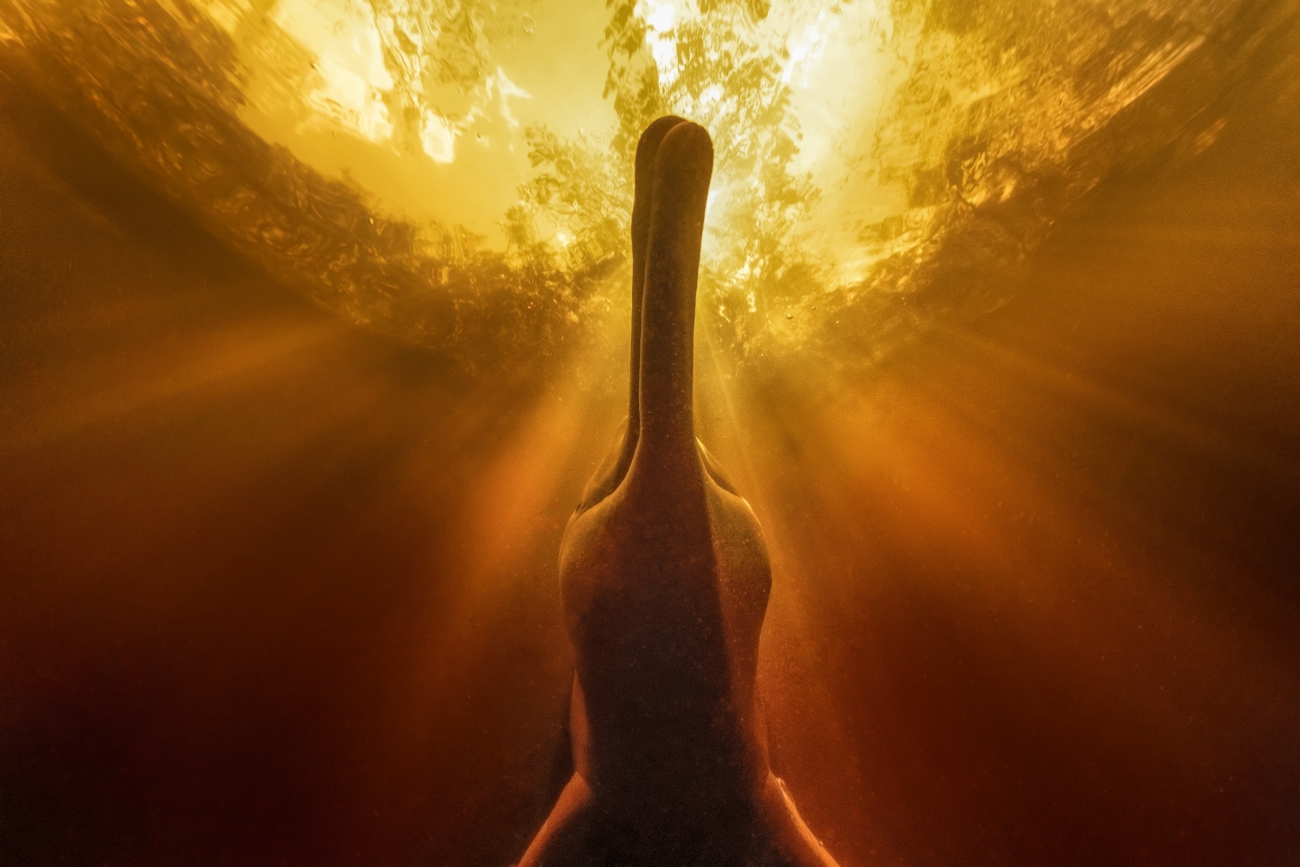
“Amazon river dolphin silhouette” by Hussain Aga Khan (Switzerland). Runner-up, PortraitsLocation: Manaus, Brazil“I spent two weeks in Manaus – where about 10 operators feed the river dolphins, which are a draw to tourists. We visited a pontoon with 4 resident botos and a beach that draws about 7 in daily. Botos look very unusual compared to other dolphins, with incredibly long rostra – with vestigial hairs on them, tiny eyes and thick bodies. The idea here was to try to get an unexpected view of a surprising animal most people have never heard about. I also wanted to make it apparent that they live beneath the forest canopy in Coca-Cola-colored water. Seeing these dolphins every day for 2 weeks made taking photographs of them incrementally easier as we became familiar with their shape, movement and behavior and even, to a certain extent, individual characters.”
Then I saw it: an octopus perched high on the reef wall.
I kicked hard against the current, raising my camera as it observed me calmly.
The tide was relentless, and I managed only four shots before it pulled me away.
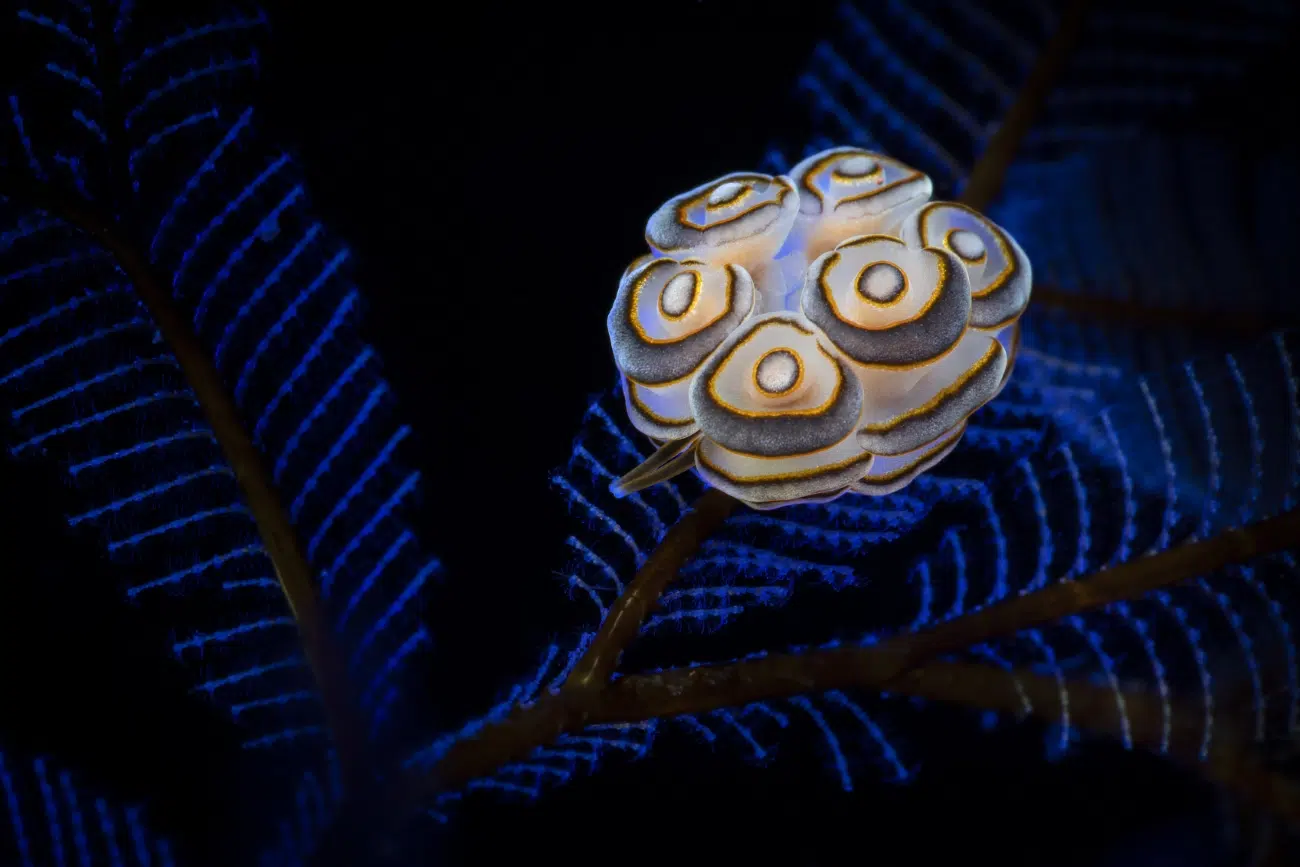
“Dazzling Donut Doto” by Bryan Blauvelt (USA). Runner-up, MacroLocation: Tulamben, Indonesia“Bali, Indonesia, is a stunning tropical paradise known for its lush rice terraces, vibrant culture, pristine beaches, and sacred temples. A perfect blend of natural beauty and spiritual charm on this special island encourages creativity, and the muck and rubble slopes of Tulamben produce a steady stream of mind-blowing critter encounters to the delight of any underwater photographer.I wanted to leave this inspirational place with a unique image of Doto greenamyeri, one of the most striking subjects in Tulamben. I created a dramatic glowing effect on the nudibranch with my strobe and snoot, and completed the frame by backlighting the host hydroid with subtle blue light to balance the composition. Thank you to my incredible guide Rudolfi Sikome at Alam Batu for holding a torch in position for the backlighting effect on this image, and for a productive and fun week of photography!”
As I drifted, I glanced back for one last look.
The octopus remained, seemingly unfazed by our encounter, but out of range.
The Beauty of the Swamp by Bryant Turffs (USA).
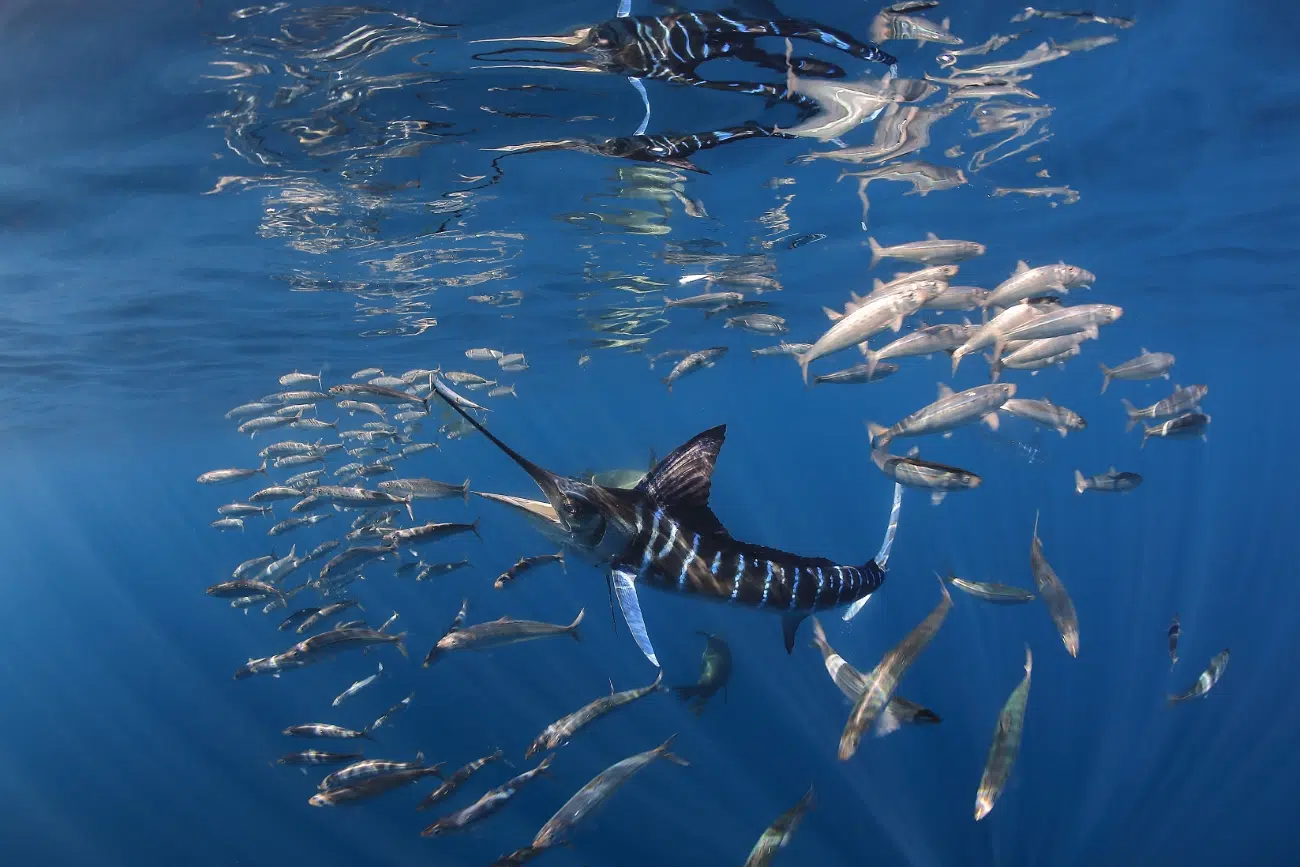
“The Moment” by Eduardo Acevedo (Spain). Runner-up, BehaviorLocation: Magdalena Bay, Baja Californina, Mexico“November-December at Magdalena Bay in Baja California, are the best months to try and get good encounters with blue marlin. However, getting strong images of these fish in wildlife is very difficult because they attack the sardines and mackerels at very high speed, making it extremely difficult to capture this behavior in a photo.”
I have revisited this spot many times trying to capture various subjects and the light just right.
The water levels vary significantly, sometimes completely drying, during different times of year.
The fish species are in constant flux, and this location is often dominated by exotics.
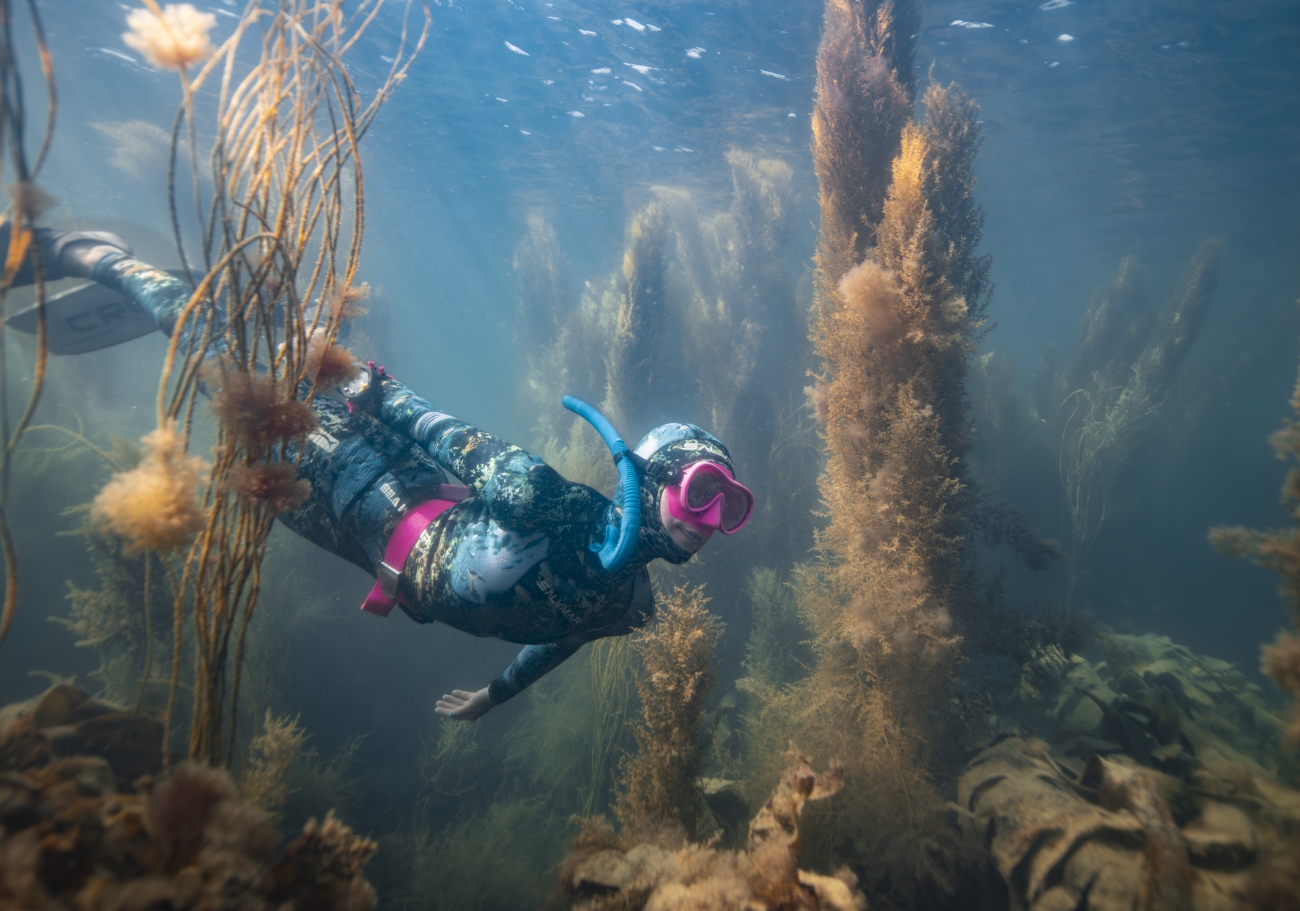
“Take a Deep Breath” by Guy Trees (UK). Runner-up, British Waters Living TogetherLocation: Balaclava Bay, Portland, UK“As the seaweed photosynthesizes around us, we seek refuge from the fast pace of daily life beneath the waves, where it is quiet. We relax, our heart rate slows down; for many people, the ocean provides a place to find peace. With no prior setup and only ambient lighting, this photo captures a freediver in a moment of tranquillity as she weaves her way through the kelp. All too soon, we surface for air.”
Amazon river dolphin silhouette by Hussain Aga Khan (Switzerland).
We visited a pontoon with 4 resident botos and a beach that draws about 7 in daily.
I also wanted to make it apparent that they live beneath the forest canopy in Coca-Cola-colored water.
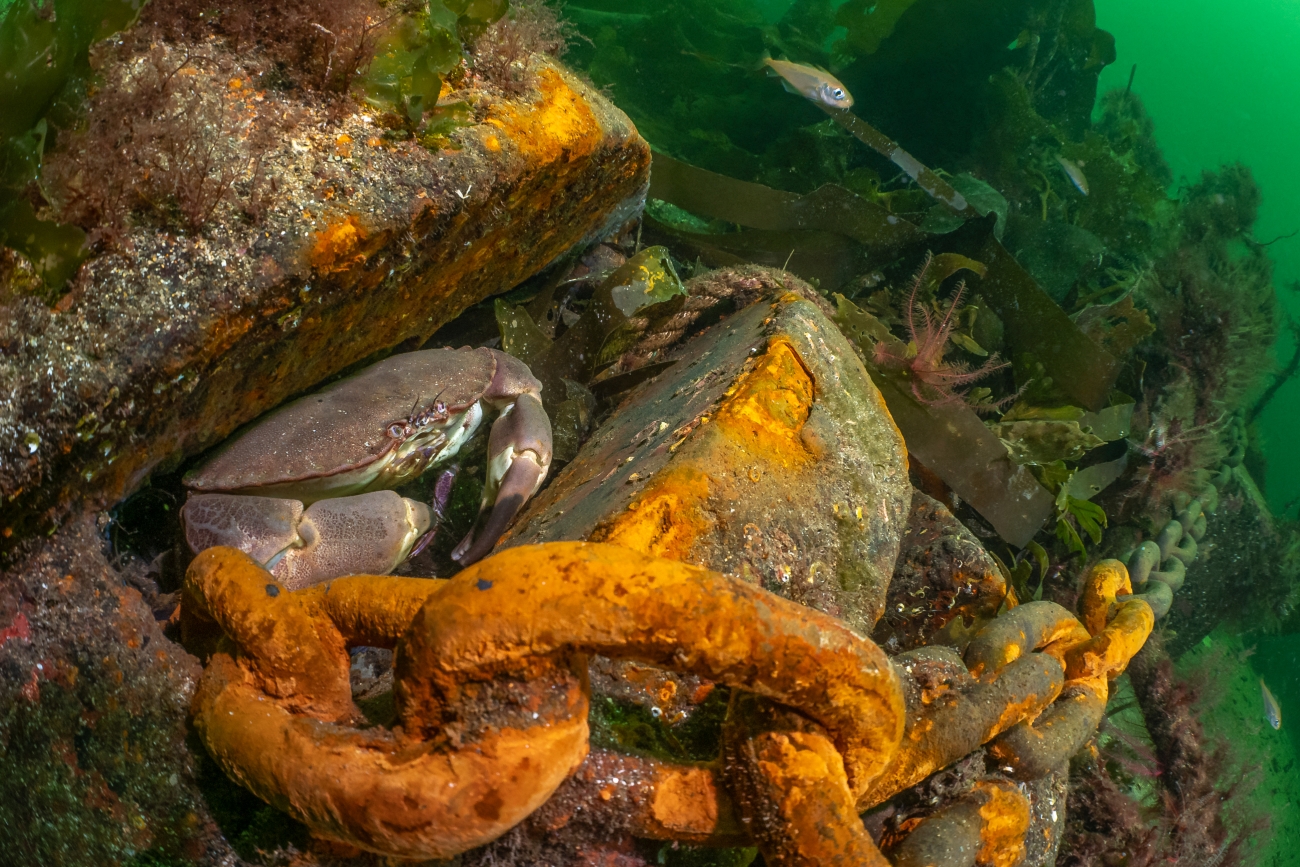
“Rusty Haven” by Dan Bolt (UK). Winner, British Waters Living TogetherLocation: Loch Carron, Scotland“This images shows nature’s ability to make the best of a bad situation. The iron block and heavy chain are actually holding a small barge in-place on the surface where local scallop divers store their equipment. The barge itself is a floating reef system all of it own, and the anchor blocks have attracted many species too.I was actually practicing for a different underwater photography competition when I took this shot. For a couple of days before an on-the-day ‘splash in’ competition, this crab was consistently in this position, or very close by. Sadly on the day it was nowhere to be seen! Happily for me though that meant I was able to use my practice photos for UPY!”
Dazzling Donut Doto by Bryan Blauvelt (USA).
The Moment by Eduardo Acevedo (Spain).
Take a Deep Breath by Guy Trees (UK).
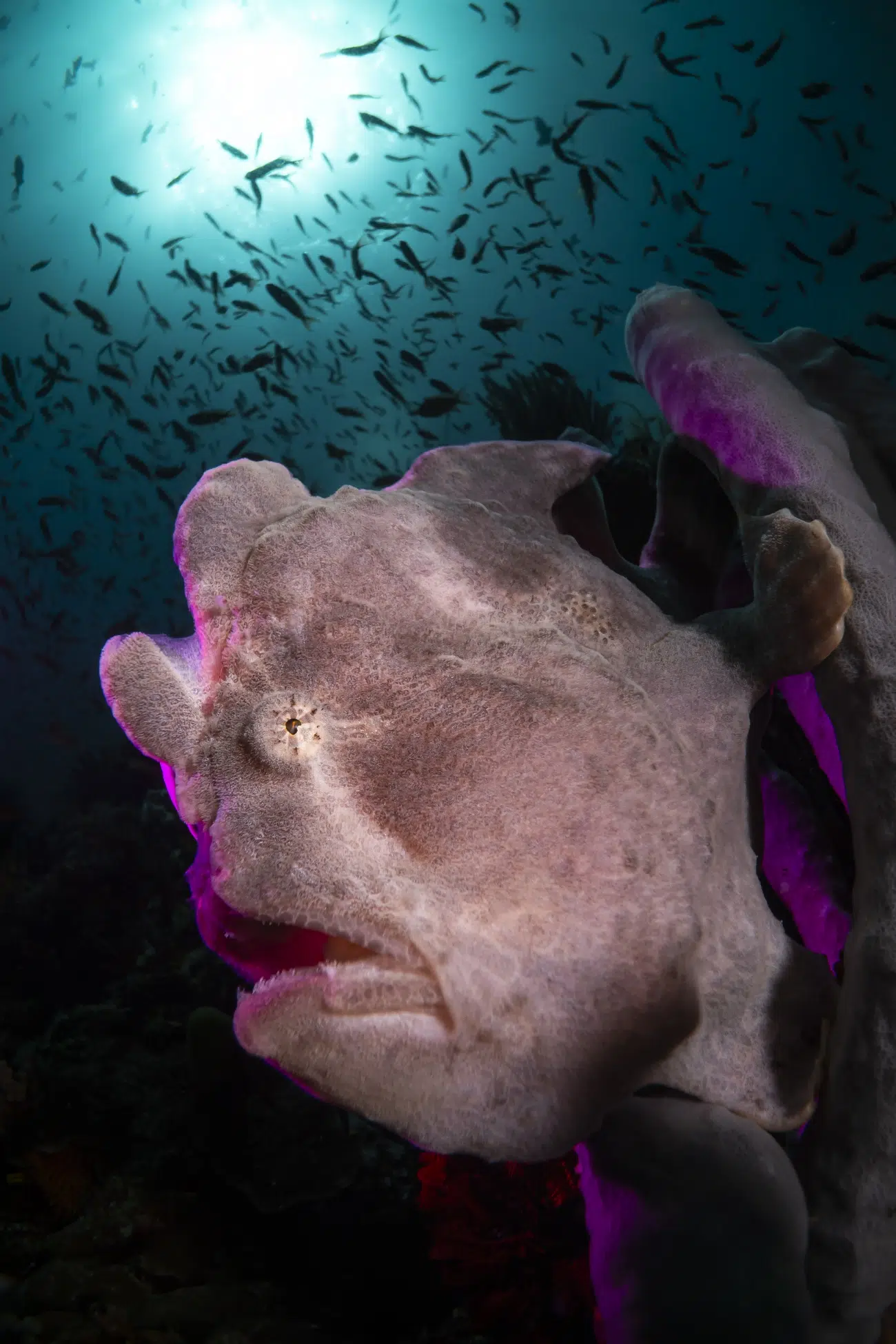
“Giant Frogfish” by Enrico Somogyi (Germany). Runner-up, CompactLocation: Anilao, Philippines“When I was diving in Anilao, in the Philippines, we found this beautiful giant frogfish at a depth of around 15m. I tried to get a picture with a colored backlight, and a background of small fish and the sun. After a couple of frames I got this picture and was very happy.”
All too soon, we surface for air.
Rusty Haven by Dan Bolt (UK).
Sadly on the day it was nowhere to be seen!
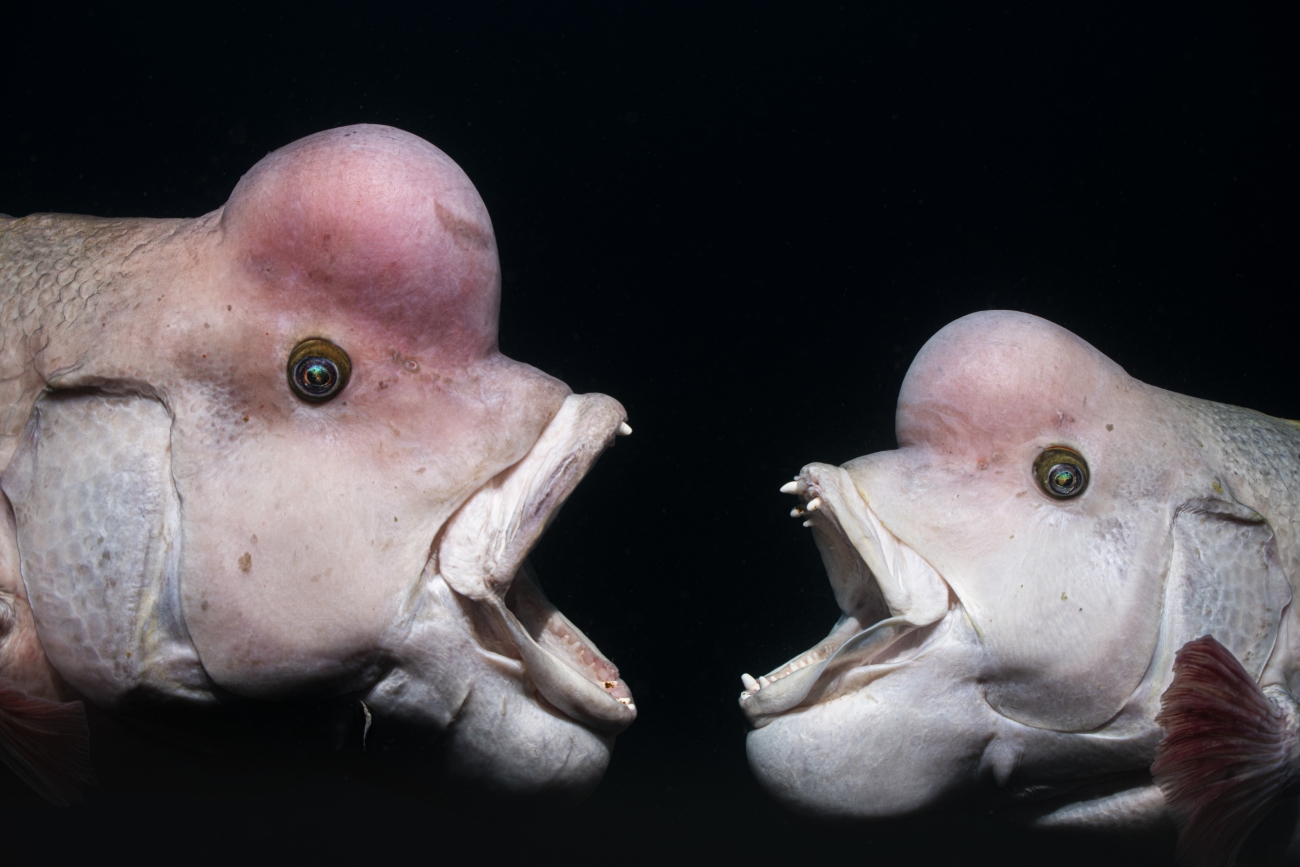
“Face Off” by Shunsuke Nakano (Japan). Winner, BehaviorLocation: Sado, Niigata, Japan“This is a photo of two male Asian sheepshead wrasse fighting. The unique form of this species is characteristic of males, who form harems and claim territories during the breeding season. The one on the left in the photo is the harem king, who has defended his territory for more than 10 years and is estimated to be over 30 years old, while the one on the right is a young challenger.Although I had planned carefully to capture the images, the 2024 season was more difficult to predict than usual, and despite staying there for a week during the breeding season, I was only able to observe this scene once, for just 10 seconds. And this was the only photograph I was able to take. The sight of them fighting in their flashy white outfits was so magnificent I can still remember it vividly.”
Happily for me though that meant I was able to use my practice photos for UPY!
Giant Frogfish by Enrico Somogyi (Germany).
After a couple of frames I got this picture and was very happy.
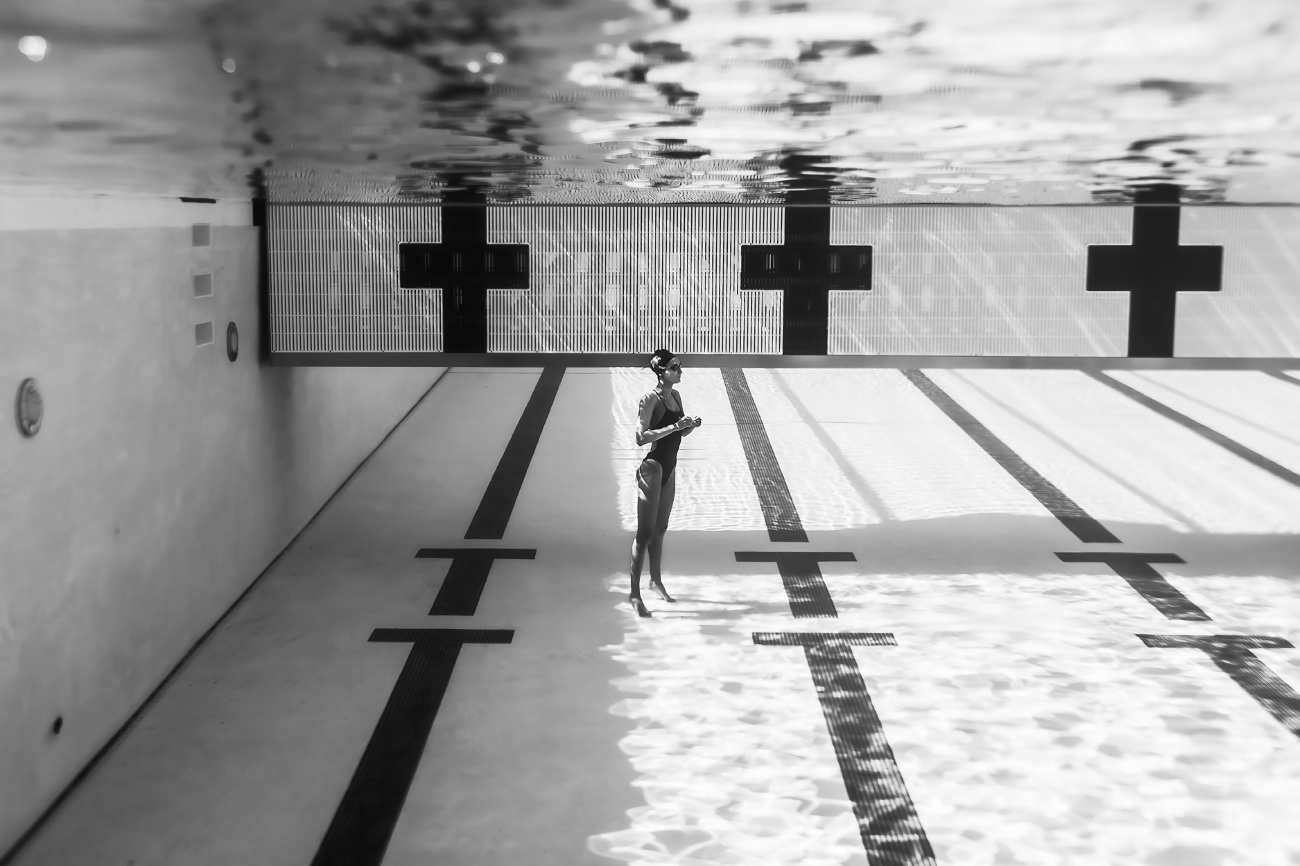
“Water Zen” by James Rokop (USA). Runner-up, Black & WhiteLocation: Los Angeles Expo Center, United States“This image was taken at the Los Angeles Olympic send-off event for the USA Olympic Artistic Swimming Team. As the event photographer, I was able to photograph the team both underwater and from land. In this shot, the swimmer is warming up before the team’s demonstration of their 2024 Paris Olympic routines by standing on the bottom of the pool engaged in a breathing exercise. Artistic swimmers have an incredible lung capacity and they are able to perform these unusual feats such as standing on the bottom of the pool, effortlessly. This was the only swimmer using the bottom of the pool like this for her warm-up and the unusual sight immediately captured my attention. The image evoked a sense of peace and calmness.”
Face Off by Shunsuke Nakano (Japan).
Winner, BehaviorLocation: Sado, Niigata, JapanThis is a photo of two male Asian sheepshead wrasse fighting.
And this was the only photograph I was able to take.
The sight of them fighting in their flashy white outfits was so magnificent I can still remember it vividly.
Water Zen by James Rokop (USA).
As the event photographer, I was able to photograph the team both underwater and from land.
The image evoked a sense of peace and calmness.